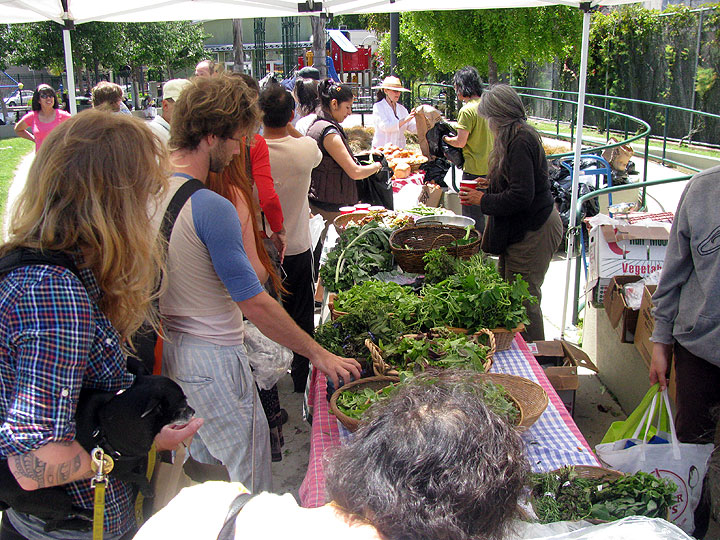Photo credit: Muffet / Foter / CC BY. Article excerpted from the book It's a Shareable Life.
The Free Farm Stand, located in the Mission district of San Francisco, distributes free food through gifting organic fruits, vegetables, and locally made breads every weekend.
The food is sourced from produce that goes unsold at farmer’s markets, and from neighborhood and community gardens, and also from public and private fruit trees. Additionally, they help grow food on donated land. The Free Farm Stand builds community and provides a meeting place for locals on tight budgets. Most learn about the Free Farm Stand by word-of-mouth as there is little to no press and barely enough information online to even deduce the time and place of the weekly event. On distribution days people start arriving around noon and request a number which will be used to admit groups of ten at a time. Many folks picnic or sit in circles on the grass and talk while they wait their turn. There is no sense that this is any sort of hand-out or cattle call, but rather a way to connect to the community, get needed food, and foster a sense of belonging.
The founder, and long-time farmer, explains “We want to improve trust and sharing through this gift economy. The idea is, if you give something, the universe will take care of you.”
While the Free Farm Stand may sound overly tree-hugger and hippy-dippy to some readers, this is a beautiful example of taking unused food that would likely be wasted otherwise and distributing it to those in need. It’s a win-win.
If you’re not motivated by the sheer altruism of the idea, think of it this way. Food insecurity drives people to seek public assistance (e.g., food stamps and other forms of welfare) that strain state and local budgets. Community-driven activities like this decrease both food insecurity and public assistance. Just another example of how sharing reduces waste, strengthens communities, and helps relieve already overburdened government budgets.
STEP 1: Get Organized.
Find a location and round up a few friends who are willing to help out. When scouting locations stick to open spaces and avoid sidewalks. The key is to be sufficiently visible to make distribution easy but not overly obtrusive as to attract, say, attention from the authorities. Small neighborhood parks are ideal, or even parking lots of local businesses who agree to let you set up there.
Keep in mind there may be local laws requiring permits before setting up a stand. It’s probably best to first check with city hall about this.
STEP 2: Collect the Food.
You might be surprised to find out there are many sources of free food out there. Go to your local farmers market when everyone is closing up and ask the produce vendors if they have any food to donate. Put together a friendly pitch about your stand and explain what you’re trying to do. Tell the vendors you’re willing to take anything that isn’t selling well or that would spoil before their next market day. You’ll be surprised how many vendors will be willing to contribute. Make sure you have crates, boxes, or bags to take away your haul.
If you live in an area where many people have fruit trees in their yards, you can also go door to door and ask them if they’d like to donate excess fruit. For example, when you drive through neighborhoods in Southern California you often see every other house with orange or lemon trees absolutely heavy with fruit. Much of this is likely to go to waste, because how many lemons can one family eat? Many home owners will be happy to give you their extras, even if it’s just to avoid the cleanup when the fruit starts falling to the ground.
You can also ask around at local bakeries and neighborhood grocery stores. Unfortunately, the large chain groceries will likely have policies forbidding food donations due to liability concerns, but the locally owned stores may be more amenable to helping you.

Photo credit: Suzies Farm / Foter / CC BY-NC-ND.
STEP 3: Get the Word Out.
Set up your distribution schedule and disseminate your information to all the local neighborhood organizations. Call your local Department of Human Services about which community outreach programs may be able to help you spread the word. You might even consider creating a Yelp page to make your stand locatable on the internet. This will establish an indexable address for your listing so that people can find the details online.
STEP 4: Distribute the Food.
This is where the rubber meets the road. You want to make sure the food gets evenly distributed but as you’re just starting out you won’t know how to gauge the demand. You might try pre-packing bags of mixed produce, bread, and whatever else you have, and give one out to each person. If fewer people than expected are showing up, you can add more food into each bag. If more people show up, your marketing campaign has been successful, and you can make adjustments next time.
STEP 5: Don’t Get Frustrated.
In the first few weeks you’ll likely be playing it by ear. It takes a while for the news to get out. Worst case scenario is that the few folks who do come will get a whole bunch of free food, which will make them likely to spread the word. Stick with it!
For more details check out the San Francisco Free Farm Stand blog at freefarmstand.org.









